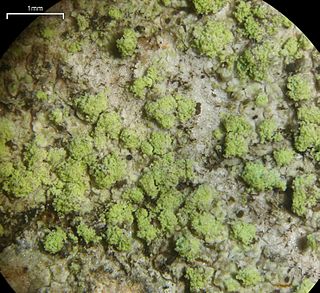
Biatora is a genus of lichens in the family Ramalinaceae. First described in 1817, the genus consists of crustose and squamulose lichens with green algal photobionts, biatorine apothecia, colorless, simple to 3-septate ascospores, and bacilliform pycnospores. According to the Dictionary of the Fungi, the genus contains 42 species that are widely distributed in temperate areas.
Biatora epirotica is a species of corticolous (bark-dwelling) lichen in the family Ramalinaceae. Found in specific regions of the Balkans and Turkey, it was described as new to science in 2011 by lichenologists Christian Printzen and Toby Spribille.
Lecanora mugambii is a species of crustose lichen in the family Lecanoraceae. Found in western Kenya, it was described as new to science in 2011.
Halecania athallina is a species of lichen in the family Leprocaulaceae. Found in Alaska, it was described as new to science in 2020 by British lichenologist Alan Fryday. The type specimen was discovered in Hoonah-Angoon Census Area in Glacier Bay National Park. There it was found growing on argillite rock on an alpine heath with rock outcrops.
Micarea pauli is a species of corticolous and lignicolous, crustose lichen in the family Pilocarpaceae. It is only known to occur in Poland's Białowieża Forest.
Lecania sessilisoraliata is a species of saxicolous (rock-dwelling), crustose lichen in the family Ramalinaceae. It is found on rock outcrops in the mountainous Burdur region of Turkey.
Biatora oxneri is a species of corticolous (bark-dwelling) lichen in the family Ramalinaceae. It is found in the Russian Far East and in South Korea.
Biatora radicicola is a species of corticolous (bark-dwelling) and saxicolous (rock-dwelling), crustose lichen in the family Ramalinaceae. It is found in various locations in Europe, where it grows in sheltered and humid microhabitats, often on exposed root bark at the base of trees.
Gallowayella aphrodites is a species of corticolous (bark-dwelling), foliose (leafy) lichen in the family Teloschistaceae. It is found in the Mediterranean countries Greece, Cyprus, and Italy. Characteristics of the lichen include its small thallus, the disposition of the rhizines on the thallus undersurface, and the lack of vegetative propagules.
Pertusaria galapagoensis is a species of corticolous (bark-dwelling), crustose lichen in the family Pertusariaceae. Found on the Galápagos Islands, it was formally described as a new species in 2015 by Elix, Yánez-Ayabaca, A.W.Archer & Bungartz. The type specimen was collected on Floreana Island at an altitude of 371 m (1,217 ft), where it was found growing on the bark of a south-exposed trunk of Cedrella odorata. The species epithet refers to its distribution.

Biatora pontica is a species of corticolous (bark-dwelling), leprose lichen in the family Ramalinaceae. It is a widely distributed species, having been recorded in Africa, Asia, Europe, and North America.
Pyxine profallax is a species of corticolous (bark-dwelling), foliose lichen in the family Caliciaceae. It is found in Australia, Papua New Guinea, and Thailand.
Megalospora austropacifica is a species of corticolous (bark-dwelling), crustose lichen in the family Megalosporaceae. It is found on the islands of Taveuni and Viti Levu in Fiji. It has a yellowish grey to whitish grey, glossy thallus that is thick and may appear slightly wrinkled or smooth, often with irregular cracks and small papillae containing conidiomata, but lacking isidia and soredia. Its apothecia are circular, up to 4.5 mm in diameter, with the disc evolving from concave to slightly convex and coloured from orange-brown to red-brown, surrounded by a thick, prominent margin.
Caloplaca nothocitrina is a species of saxicolous (rock-dwelling), crustose lichen in the family Teloschistaceae. Its thallus is up to 8 mm in diameter and deep yellow in colour. It comprises small dispersed areoles, occasional concave soralia, and circular apothecia with a bright yellow margin and a dull dark yellowish or brownish disc.
Biatora toensbergii is a species of corticolous (bark-dwelling), crustose lichen in the family Ramalinaceae. It is found in Norway and northwestern North America.
Arthonia toensbergii is a species of lichenicolous (lichen-dwelling) fungus in the family Arthoniaceae. It occurs in old-growth boreal rainforests in Norway, where it parasitises the lichen Mycoblastus affinis growing on trunks and branches of Norway spruce.
Lecidea toensbergii is a species of saxicolous (rock-dwelling), crustose lichen in the family Lecideaceae. Described as a new species in 2018, it has been documented from several locations in Norway and a single location in Sweden, where it grows in rocky alpine environments.
Biatora bacidioides is a species of corticolous (bark-dwelling), leprose lichen in the family Ramalinaceae. It was formally described as a new species in 2003 by the lichenologists Christian Printzen and Tor Tønsberg, from specimens collected from Picea orientalis forests of north-eastern Turkey. It was recorded from Ukraine in 2018.
Biatora chrysanthoides is a species of corticolous (bark-dwelling), leprose lichen in the family Ramalinaceae. It is found in Norway, the Pacific Northwest of northern North America, Sweden, and Russia. It was formally described as a new species in 2003 by the lichenologists Christian Printzen and Tor Tønsberg. It contains gyrophoric acid in both the thallus and the apothecia, resulting in a C+ chemical spot test reaction. Its ascospores are 9.3–10.7 by 3.2–3.3 μm.
Biatora pausiaca is a species of corticolous (bark-dwelling), leprose lichen in the family Ramalinaceae. Found in the United States, it was formally described as a new species in 2003 by the lichenologists Christian Printzen and Tor Tønsberg. Its ascospores are 3.5–6.5 μm wide, and it does not contain any lichen products detectable with thin-layer chromatography. It is closely related to Biatora vezdana; these two species form a clade that itself has a sister relationship with Biatora radicicola.

